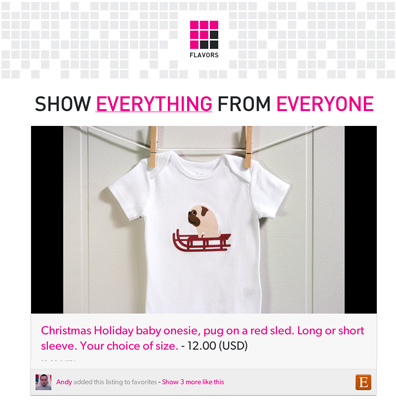
Oversharing is an overwhelming problem online. Keeping up with all your news and interests and social channels can be exhausting--it's why innumerable aggregators exist (from Huffington Post to Reddit and Pinterest) to help us manage our consumption habits.
Today, the startup Flavors.me takes another swipe at the problem, launching a new version of the service aimed at tackling our social media A.D.D. Founder Jonathan Marcus says he wants Flavors to become a "catch-all" for social content, a stream designed to aggregate fragmented social services. "I want a website that lets the content really shine," he says. "I want a website that showcases me and those close to me in a visual way, and change how social content is presented."
[vimeo 32789245]
The new version of Flavors culls content from about three-dozen sources: everything from Facebook to Instagram, Foursquare to Flickr, Netflix to Last.fm, Etsy to Tripit. Add a couple channels, follow a few friends, and you'll instantly create a stream of content across all networks. The idea is to curate and not simply aggregate our social content--Flavors comes with a sleek tool to easily filter out sources and people, which is easily the service's best feature. "Our most compelling content is splintered across a wide variety of channels," Marcus says. "We wanted to fill in the content that you're not otherwise getting access too."

Of course, myriad services have attempted to solve the fragmentation problem. Marcus acknowledges this fact but argues none have done so with the startup's focus on design. Bounce around Flavors and you'll notice elements of About.me or FriendFeed; the social streams are reminiscent of Tumblr, Google+, or Facebook, too. How can a small startup keep pace with so much competition from such large players as Facebook? "You could argue that it'd be easier for Facebook to integrate 75 services because those 75 services are doing the integration themselves," he says. "The corollary is they're not integrating as well as they could be. The design sensibility is not there."
In other words, many services take advantage of Facebook's API to gain access to its large social graph. Flavors takes the opposite approach: It takes advantage of the APIs from other services, and builds its own integration, thus maintaining a consistent design aesthetic. "The new Facebook activity stream is a data feed of everything you've done, but it's just one sentence highlights," Marcus says. "We're showing as big of an image as possible [with each post] because we want to show off the content."
The results are sometimes mixed. On one hand, high-res Etsy images or shared tracks from Hype Machine look very appealing on Flavors. But status updates ported from Facebook or recently watched items shared from Netflix, which simply include a small movie title and poster thumbnail, seem boring by comparison--posts almost designed to be glossed over and skipped. This is a limitation of the external feed being pulled in and not the fault of Flavors, but a limitation nonetheless.
Other aspects of Flavors's upgrade are promising, including the new mobile site and custom homepage displays. Flavors.me, like About.me, gives users the ability to create their own splash pages complete with links to various social media channels--sort of a all-in-one web ID. But there are downsides too. To gain access to the mobile site, all custom layouts, and a real-time analytics dashboard, for example, users must upgrade to the premium service, for $20 a year.

There's also the question of whether Flavors is significant enough to remain its own separate service, or whether it should be a layer built on top of Facebook's social graph. After all, Facebook has far more users and far more support from other services. And the more Facebook pushes its visual aesthetic across the network--like bringing in top designers to take on Timeline--the harder it might become for Flavors to distinguish itself.